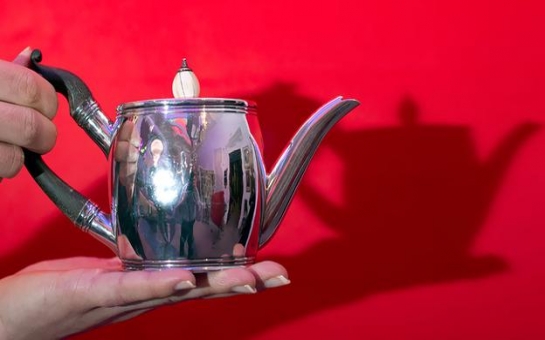Al Capone’s cocktail shaker… A crystal flask from the Titanic… One-hundred-million-year-old fossilised dinosaur eggs… A dog balancing a washing machine on its nose… Silver plates made for King George II… A shop sign in the form of a large revolver… The list of weird and wonderful things bought by the reclusive millionaire Stanley Seeger sums up his eccentricity and love of the quirky as well as for heavyweight modern art.In his lifetime Seeger, heir to a massive oil and timber fortune, spent hugely on art – and then sold and moved on. In 1993, when the market was in the doldrums, he successfully offloaded 88 Picassos for an eye-popping $32m. He bought the imposing Tudor mansion, Sutton Place, in the English countryside from the estate of John Paul Getty, and shocked visitors by hanging a Bacon triptych of nude figures in its great hall. But the house was too big, and too public for him. He sold, again, and found somewhere more discrete – a thatched house in Devon, to add to his many other homes around the world.This month, almost three years after Seeger’s death, Sotheby’s was tasked with knocking down another Seeger hoard – almost 1,000 items culled from his homes and his 1930s yacht. It was, in truth, a bit of a garage sale, with highly desirable pieces – such as a drawing by the Surrealist Kay Sage or a table by Giacometti’s brother Diego – offered alongside some things that, without the magic Seeger provenance, would hardly have raised an eyebrow let alone a bidding paddle.Immaculate collectionSifting through the mass of material – Seeger and his partner Christopher Cone were veritable shopaholics – was a daunting task. The trove spanned 25 departments and 75 collecting categories, from antiquities to Victorian painting. Sotheby’s finally divided the 991 lots into 12 themes, and the chunky catalogue was colour-coded to help buyers find their way around. Sotheby’s even looked at homeware catalogues – with their range of everything from linen to lighting – to see how to organise the offerings.One thing was clear: everything had to go; Cone didn’t want it back. So the specialists estimated low, putting what the auction houses call ‘come hither’ prices on the works. “We based our pricing on what the pieces would have sold for without the Seeger provenance,” explained David Macdonald, in charge of the sale. So up for grabs, for instance, was a poster of boxing kangaroos (estimated at £50/$84; made £563/$943) or a French asparagus dish (£80/$134; made £175/$293).Sotheby’s threw its powerful marketing know-how behind the sale. Groups of young collectors, city slickers and regular clients were invited to Sotheby’s grand board room overlooking London’s Bond Street, where they ate off Paul de Lamerie silver plates (£12,000-£18,000/$20,000-$30,000; made £30,000/$50,000), could summon the waiters with silver tortoises with bells in their tails (£1,500-£1,800/$2,500-$3,000; made £5,625/$9,420) – and even be served from Al Capone’s silver pitcher. Ads were plastered in newspapers and interior magazines: some played ball and ran profiles of the upcoming sale and its eccentric owner.Behind the scenes, bids were being left. .“Specialists, the bids department, the auctioneers – we all had regular meetings in the run-up to the sale,” explains Macdonald. “We looked at which lots were generating a lot of interest – and which weren’t. If something wasn’t popular, we would make sure clients with an interest in that area had been contacted,” he says.Then there was the party, held two days before the sale. By then auction house staff had crammed the whole trove into its premises, arranged by theme: natural history, design, flora and fauna… In the spirit of the jazz age, invitees were greeted by a three-man steel band, while waitresses in gold lamé jackets offered strawberry daiquiris. The guests circulated gingerly among the pieces, which included a sculpture of a Dalmatian balancing a washing machine on its nose (David Mach, estimated at £3,000-£5,000/$5,000-$8,300; made £6,875/$11,500). Outside in Bond Street, chauffeurs waited beside Bentleys and Rolls Royces.Going, going, goneThe sale took place over two days, with a series of auctioneers; kicking it off was the firm’s aristocratic UK chairman, the towering Henry Wyndham. An ace on the auction rostrum, Wyndham has countless big prices to his name, notably Giacometti’s Walking Man I, 1959, which sold for £65m ($109m) in 2010, and his particular favourite, Rubens’ Massacre of the Innocents from about.1611-12, sold in 2001 for £49.5m ($83m).In major evening sales, where artworks in the tens of millions of dollars are traded, an auctioneer such as Wyndham knows in advance where the bids are likely to come from– he even knows where bidders are placed in the room. But the Seeger sale was different – a marathon, with 2,000 hopefuls on the phone, bidding online or in the room. Not knowing most of them, he had to use what he calls his “radar”: “I can generally tell when someone is about to bid in the room: they sort of stiffen up, become more alert,” he says.Single-owner sales such as the Seeger one tend to be a slam-dunk for the auction houses: bidders are generally prepared to pay well over the odds to bag something with the magic provenance. Seeger was no different: at the end of a long two days the firm was celebrating raising almost double expectations: £7.3m ($12.2m), with just 55 lots unsold. The Giacometti table had soared to £266,500 ($447,000). As for Al Capone’s cocktail pitcher – it made a stunning £50,000 ($84,000), trouncing its £1,000-£1,500 estimate. And the old gangster would certainly have drunk to that.(BBC)ANN.Az
How Sotheby's sold the Seeger Collection
Culture
15:19 | 11.03.2014

How Sotheby's sold the Seeger Collection
Nearly 1,000 items from the eccentric collection of a reclusive millionaire have gone under the hammer in London, with buyers bidding for a trove of bizarre objects. Georgina Adam goes inside an auction with a difference.
Follow us !










